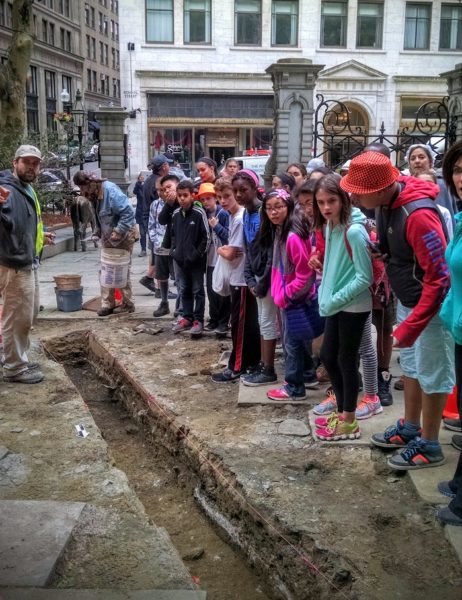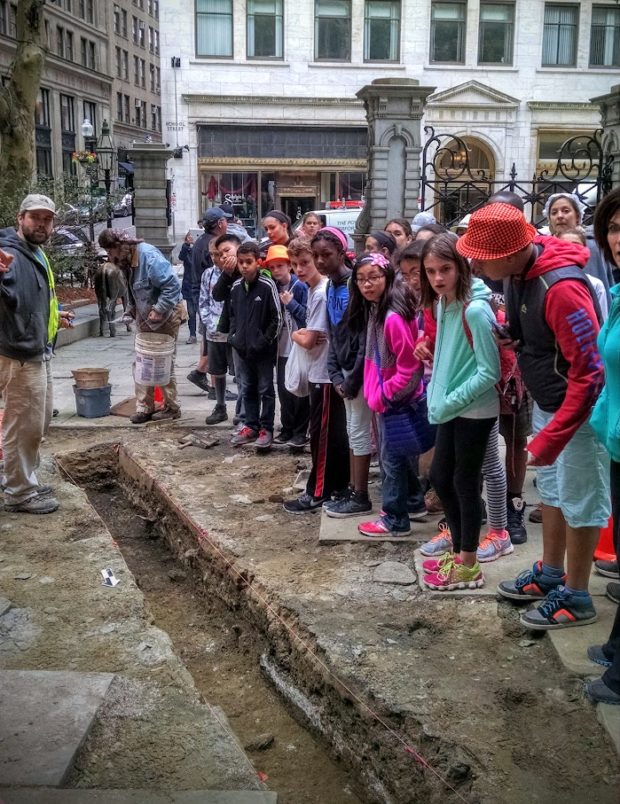By Sarah Johnson

Archaeology in a densely populated urban environment is an entirely different animal from doing some quiet shovel test pits in the woods. Throw in the element of working along a main tourist thoroughfare that attracts millions of visitors each year, and you’ve got yourself a real logistical challenge. How do we as archaeologists engage that volume of visitors while maintaining a safe, well-paced work environment? What follows are some of my thoughts on these issues, based on my experience on urban archaeology projects along Boston’s Freedom Trail, at the home of Malcolm X in Roxbury, Massachusetts, and on Burial Hill in Plymouth.
The first and most important rule of urban public archaeology, as with Boy Scouts, is to be prepared. Really think through your strategy beforehand and keep in mind that there will be challenges that you might not be used to facing.
- Safety: If you are in a setting where visitors will be able to walk right up to your excavation units, how will you keep them (and your crew) safe? Some sort of barrier may be in order, but also keep in mind that anything that keeps people from being able to see what you’re doing will be a turn-off. In my experience, a row of traffic cones usually does the job. Also consider how you’ll protect the site at night. Sand bags filled with backdirt are a great asset to have – you can use them to hold down the plywood or whatever else you use to cover your units, and you can also use them to line the bottom of your units to deter anyone who manages to get your covering off.
- Interpretation: If your crew is large enough, it helps to have people whose job it is to just interpret the site for visitors. This allows excavation to continue more or less unimpeded while also insuring that the public is engaged. In any crew, there will likely be a few people who really take to this role, saving those who are less outgoing from anything they find unpleasant. At the start of the project, lay out some talking points that you want the interpreters to be sure to hit and then let people find their own voice. You will find that you get the same few questions over and over again (“Have you found anything yet?” “What’s the coolest thing you’ve found so far?” “Found any gold?”), so it won’t be long before you start to hit your stride. If possible, set up your screens in a space where the public can watch. That way, they can see the entirety of the fieldwork process at once. You can even take it one step further by setting up a public lab space. This is obviously not feasible for many projects, but it can be a really great way to highlight the scientific nature of archaeology and give visitors a sense of the true scope of our work, not just the digging. For the project I worked on in Plymouth, we set up a lab in the visitors’ center at Plimoth Plantation where members of the crew could wash and sort artifacts from the field and talk with visitors. Even just a small washing station on site can go a long way to expanding people’s ideas of what archaeology is.
- Follow-up: How will you continue to engage your visitors after they leave the site? The turnaround on urban public digs can be very fast, as people stop by for a few minutes as part of a tour or while they’re on the way to their next planned stop. It’s important to make a connection in the few moments you have and give them a way to continue to follow your work. Signage is a big part of this, so you should create some bright, eye-catching signs to place around the site that give a brief idea of who you are and what you are doing. That way, even if the visitor doesn’t get a chance to talk with anyone, they still have an idea of what they’re looking at. Going back to Joe Bagley’s blog post earlier this month, social media is a great way to engage people beyond the site itself. Prominently display your Facebook/Twitter/Instagram/etc. links on your signs, and include any hashtags that you’ve come up with for your project. The hashtag encourages people to not only follow along but also post about their experiences at the site in a way that others can find. Make sure that you post about your progress often so that there is some encouragement to keep following.
Above all, be flexible and maintain a sense of humor. Public archaeology on this scale can be overwhelming and exhausting, but it is also incredibly rewarding. You have the opportunity to bring your work to literally millions of people, and with just a little effort and planning on your part, you can leave them with an unforgettable experience. What message do you want to tell the world about archaeology? This is your chance to share it. Good luck and have fun!

